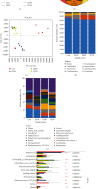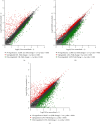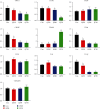Quercetin Increases Growth Performance and Decreases Incidence of Diarrhea and Mechanism of Action in Weaned Piglets
- PMID: 39139212
- PMCID: PMC11321896
- DOI: 10.1155/2024/5632260
Quercetin Increases Growth Performance and Decreases Incidence of Diarrhea and Mechanism of Action in Weaned Piglets
Abstract
This study aimed to investigate the mechanism of quercetin increasing growth performance and decreasing incidence of diarrhea in weaned piglets. Forty-eight Duroc × Landrace × Large White weaned piglets with similar body weight (7.48 ± 0.20 kg, 28 days of age) were randomly divided into four treatments (control, 250 mg/kg quercetin, 500 mg/kg quercetin, and 750 mg/kg quercetin treatments) and fed with basal diet or experimental diet supplemented with quercetin. Performance, diarrhea rate and index, and content of serum anti-inflammatory factors were determined and calculated in weaned piglets; colonic flora and signaling pathways related to anti-inflammation were measured using 16S rDNA sequencing and RNA-seq, respectively. The results showed that compared with control, feed-to-gain ratio and content of serum interferon gamma (IFN-γ) were significantly decreased in the 500 and 750 mg/kg quercetin treatments (P < 0.05); quercetin significantly decreased diarrhea rate and diarrhea index (P < 0.05) and significantly increased the content of serum transforming growth factor (TGF-β) in weaned piglets (P < 0.05); the content of serum NF-κB was significantly decreased in the 750 mg/kg quercetin treatment (P < 0.05); moreover, quercetin significantly increased diversity of colonic flora (P < 0.05), and at the phylum level, the relative abundance of Actinobacteria in the 500 and 750 mg/kg treatments was significantly increased (P < 0.05), and the relative abundance of Proteobacteria in the three quercetin treatments were significantly decreased (P < 0.05) in the colon of weaned piglets; at the genus level, the relative abundance of Clostridium-sensu-stricto-1, Turicibacter, unclassified_f_Lachnospiraceae, Phascolarctobacterium, and Family_XIII _AD3011_group was significantly increased (P < 0.05); the relative abundance of Subdollgranulum and Blautia was significantly decreased in the 500 and 750 mg/kg treatments (P < 0.05); the relative abundance of Eschericha-Shigella, Terrisporobacter, and Eubacterium-coprostanoligenes was significantly increased (P < 0.05); the relative abundance of Streptocococcus, Sarcina, Staphylococcus, and Ruminococcaceae_UCG-008 was significantly decreased in the three quercetin treatments (P < 0.05); the relative abundance of Ruminococcaceae_UCG_014 was significantly increased in the 250 mg/kg quercetin treatment in the colon of weaned piglets (P < 0.05). The results of Gene Ontology (GO) analysis and Kyoto Encyclopedia of Genes and Genomes (KEGG) pathway analysis showed that differentially expressed genes (DEGs) from the quercetin treatments were significantly enriched in nuclear transcription factor-κB (NF-κB) signal pathway (P < 0.05); mRNA expression of tumor necrosis factor-α (TNF-α), interleukin-1R1 (IL-1R1), conserved helix-loop-helix ubiquitous kinase (CHUK), toll-like receptor 4 (TLR4), and IL-1β from quercetin treatments were significantly decreased in colonic mucosa of weaned piglets (P < 0.05). In summary, quercetin increased feed conversion ratio and decreased diarrhea through regulating NF-κB signaling pathway, controlling the balance between anti-inflammatory and proinflammatory factors, and modulating intestinal flora, thus promoting the absorption of nutrients in weaned piglets. These results provided the theoretical foundation for applying quercetin in preventing weaning piglets' diarrhea and animal husbandry practices.
Copyright © 2024 Yanjun Mao et al.
Conflict of interest statement
The authors declare that they have no conflicts of interest.
Figures





Similar articles
-
Berberine alleviates ETEC-induced intestinal inflammation and oxidative stress damage by optimizing intestinal microbial composition in a weaned piglet model.Front Immunol. 2024 Sep 16;15:1460127. doi: 10.3389/fimmu.2024.1460127. eCollection 2024. Front Immunol. 2024. PMID: 39351242 Free PMC article.
-
Dietary fermented soybean meal replacement alleviates diarrhea in weaned piglets challenged with enterotoxigenic Escherichia coli K88 by modulating inflammatory cytokine levels and cecal microbiota composition.BMC Vet Res. 2020 Jul 14;16(1):245. doi: 10.1186/s12917-020-02466-5. BMC Vet Res. 2020. PMID: 32664940 Free PMC article.
-
Positive effects of a Clostridium butyricum-based compound probiotic on growth performance, immune responses, intestinal morphology, hypothalamic neurotransmitters, and colonic microbiota in weaned piglets.Food Funct. 2019 May 22;10(5):2926-2934. doi: 10.1039/c8fo02370k. Food Funct. 2019. PMID: 31070611
-
Effects of α-glycerol monolaurate on intestinal morphology, nutrient digestibility, serum profiles, and gut microbiota in weaned piglets.J Anim Sci. 2022 Mar 1;100(3):skac046. doi: 10.1093/jas/skac046. J Anim Sci. 2022. PMID: 35167667 Free PMC article.
-
The Mechanism of Zinc Oxide in Alleviating Diarrhea in Piglets after Weaning: A Review from the Perspective of Intestinal Barrier Function.Int J Mol Sci. 2024 Sep 18;25(18):10040. doi: 10.3390/ijms251810040. Int J Mol Sci. 2024. PMID: 39337525 Free PMC article. Review.
Cited by
-
Quercetin Can Alleviate ETECK88-Induced Oxidative Stress in Weaned Piglets by Inhibiting Quorum-Sensing Signal Molecule Autoinducer-2 Production in the Cecum.Antioxidants (Basel). 2025 Jul 11;14(7):852. doi: 10.3390/antiox14070852. Antioxidants (Basel). 2025. PMID: 40722957 Free PMC article.
-
The effects of Fraxini cortex and Andrographis herba on Escherichia coli-induced diarrhea in chicken.Poult Sci. 2025 Feb;104(2):104824. doi: 10.1016/j.psj.2025.104824. Epub 2025 Jan 16. Poult Sci. 2025. PMID: 39874706 Free PMC article.
References
-
- Lallès J.-P., Bosi P., Smidt H., Stokes C. R. Weaning—a challenge to gut physiologists. Livestock Science . 2007;108(1–3):82–93. doi: 10.1016/j.livsci.2007.01.091. - DOI
MeSH terms
Substances
LinkOut - more resources
Full Text Sources
Medical
Miscellaneous

